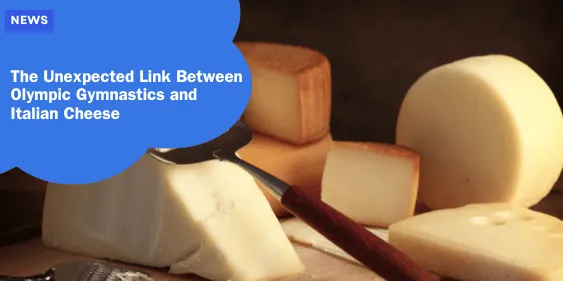The Unexpected Link Between Olympic Gymnastics and Italian Cheese

Giorgia Villa’s Olympic Success
When you think of the Olympics, images of unparalleled athleticism and intense competition likely come to mind.
Italian gymnast Giorgia Villa showcased such athleticism, contributing to the Italian women’s gymnastics team earning a silver medal—Italy’s first in the event in 96 years.
At just 21 years old, the Lombardy native has demonstrated extraordinary skill and dedication, capturing the hearts of gymnastics fans worldwide.
Viral Fame through Parmigiano-Reggiano Sponsorship
While Villa’s athletic accomplishments are noteworthy, her fame took an unexpected turn due to her sponsorship by the Consorzio del Formaggio Parmigiano-Reggiano in 2021.
The marketing campaign featured Villa in a unique photoshoot where she posed with wheels of the iconic Parmesan cheese.
Villa’s enthusiastic portrayal with Parmesan cheese gained her newfound fame beyond the gymnastics community.
The Surprising Connection
The partnership might seem odd at first: what does a world-class athlete have to do with an artisanal cheese? However, the pairing makes more sense upon closer inspection.
Like gymnastics, producing Parmigiano-Reggiano requires precision, skill, and a commitment to tradition.
The cheese is made under strict regulations, aged for a minimum of 12 months, and each wheel is inspected for authenticity.
This meticulous process mirrors the disciplined training and preparation that athletes like Villa undergo.
Thus, the collaboration highlights the dedication and artistry present in both sports and culinary excellence.
With this intriguing backdrop, we can now delve into the details of Villa’s iconic photoshoot and how it catapulted her to a new level of fame.
The Viral Photoshoot
When Giorgia Villa performed her gymnastics routine with giant wheels of Parmigiano-Reggiano, she created more than just a whimsical photoshoot – she crafted a marketing masterpiece.
The images, masterfully shot by photographer Gabriele Seghizzi, showcased Villa’s athletic prowess intertwined with Italy’s rich culinary heritage.
Seghizzi’s Artistic Vision
Photographer Gabriele Seghizzi played a pivotal role in crafting these memorable images. His vision was clear: to meld the rigor and finesse of gymnastics with the beauty and tradition of Parmigiano-Reggiano cheese.
Villa was photographed executing handstands and cartwheels beside the enormous cheese wheels.
In one notable image, she hugs a wheel close to her chest, while another shows her savoring a mouthful of the famed cheese, highlighting the playful side of this otherwise serious athlete Italian Gymnast Giorgia Villa.
Social Media Impact
These images struck a chord with the public, quickly going viral. Social media, particularly Instagram and Twitter, lit up with shares and comments celebrating the blend of sports and cuisine.
Posts ranged from humorous takes to heartfelt praises of Villa’s dual celebration of Italian excellence.
The curiosity and delight surrounding such an unusual pairing turned into a whirlwind of social media buzz, making it a trending topic and cementing Villa’s and Parmigiano-Reggiano’s places in the online world.
Public Reaction
Public reaction was overwhelmingly positive. Fans of gymnastics admired Villa’s skills, while food lovers appreciated the nod to one of Italy’s most cherished products.
The campaign not only elevated Villa’s profile but also brought additional spotlight to the Emilia-Romagna region, famed for its culinary delights.
This unique blend of sports and food created a harmonious and engaging narrative that captured global attention.
The photoshoot served as a powerful reminder of the unexpected yet impactful ways food and sports can intersect, creating memorable and effective marketing campaigns.
Parmigiano-Reggiano: A Culinary Heritage
Origins and Production of Parmigiano-Reggiano Cheese
Parmigiano-Reggiano, often simply called parmesan, stems from a defined region in Italy.
This divine cheese can only be crafted in the provinces of Parma, Reggio Emilia, Modena, Bologna, and Mantova.
This strict geographic boundary ensures the authenticity and consistent quality of Parmigiano-Reggiano.
According to tradition, the cheese has been produced in this manner for centuries, lending it a revered status in the culinary world.
The production process is a true marriage of art and science. Local cows, fed on a controlled diet, provide the essential ingredient—milk.
It takes around 550 liters of this milk to create one of the iconic giant cheese wheels. Right from the onset, meticulous care and expertise are poured into every step, ensuring that every wheel achieves the perfect balance of texture and flavor.
Strict Regulations and Aging Process
Stringent regulations govern the production of Parmigiano-Reggiano, underscoring its uniqueness. Once formed, the cheese must age for at least 12 months.
This aging period is critical because it allows the complex flavors to develop and mature. Some varieties are aged for 24, 36, or even 40 months, each milestone adding nuances to the taste profile.
At the 12-month mark, a trained inspector taps each wheel with a specialized hammer to assess its progress.
This acoustic check helps in determining whether the cheese meets the high standards set forth by the Consorzio del Formaggio Parmigiano-Reggiano.
Only then does the wheel earn its prestigious branding as a genuine Parmigiano-Reggiano.
Authenticity Measures and Branding
To prevent counterfeiting and ensure each wheel’s traceability, Parmigiano-Reggiano is given an identity number at the very beginning.
This number not only verifies its origin but also allows consumers to trace back the cheese to its specific factory of production.
Each wheel is branded—literally—with a mark that certifies its authenticity.
This rigorous process of verification means that every bite of Parmigiano-Reggiano carries the legacy and tradition of its region.
The level of dedication and care involved in its creation makes it much more than a simple cheese; it embodies a rich culinary heritage.
With our exploration of the unique artistry involved in creating Parmigiano-Reggiano, it’s essential to understand why Emilia-Romagna, with its wealth of gastronomic treasures, is considered Italy’s culinary heartland.
Emilia-Romagna: Italy’s Gastronomic Hub
Spotlight on the Region’s Culinary Specialties
Emilia-Romagna, often celebrated as Italy’s culinary heartland, is home to a cornucopia of iconic foods.
The region boasts a rich array of traditional dishes and ingredients, combining to form a gastronomy that’s hard to beat.
The culinary landscape is incredibly diverse, offering specialties such as:
- Prosciutto di Parma: This world-famous ham is cured to perfection and enjoyed thinly sliced, often served with rustic bread or melon.
- Balsamic Vinegar of Modena: An aged, richly flavored vinegar that adds depth to salads, meats, and even desserts.
- Tortellini: Small, stuffed pasta typically filled with pork, ham, and cheese, often served in a savory broth.
- Tagliatelle al Ragù: Also known worldwide as Bolognese, this hearty meat sauce clings to ribbon-like pasta for a mouthwatering combination.
- Modena’s Zampone and Cotechino: These pork sausages are seasoned and cooked to savory perfection, often served with lentils or braised greens.
Other Famous Products from the Area
Apart from Parmigiano-Reggiano, Emilia-Romagna offers other culinary treasures that attract food lovers:
- Culatello di Zibello: A refined and flavorful variety of prosciutto, aged in specific environmental conditions for unique taste and texture.
- Mortadella: A type of Italian sausage known for its soft texture and peppercorn-studded slices.
- Lambrusco: A sparkling red wine native to this region, enjoyed for its fruity and refreshing qualities.
Importance of Food Culture in Italian Identity
Food in Emilia-Romagna is more than just sustenance—it’s a way of life, a craft honed over generations.
Culinary traditions are deeply intertwined with the region’s identity, influencing social gatherings, festivals, and daily routines.
Integral to the Italian way of life, meals are not only occasions for nourishment but also for bringing people together, celebrating heritage, and creating lasting memories.
Understanding the rich, gastronomical culture of Emilia-Romagna leads to an appreciation of why food is such a powerful connector, even making unexpected pairings, like that of an Olympic gymnast and cheese, resonate so profoundly.
The love for good food, after all, is a universal language.
Exploring Parmesan Country
Bologna and Parma as Foodie Destinations
Bologna and Parma, nestled in the heart of Emilia-Romagna, are indispensable to any food lover’s itinerary.
Bologna, with its medieval streets near the Basilica of San Petronio, offers an abundance of markets that have thrived since the Middle Ages.
Here, you can traverse through shops that boast a staggering variety of cheeses, meats, and pastas.
Parma, though less visited, is truly the spiritual home of Parmigiano-Reggiano.
This tranquil city is dotted with delicatessens that invite you to taste different aged cheeses before making your purchase. Bars and restaurants here serve up tantalizing taglieri, massive platters of mixed cheeses and cold cuts.
Opportunities for Cheese Tastings and Factory Tours
For an immersive experience, head into the hills around Parma, where you can visit one of many cheese factories or producers.
From 12 months to 36 months or more, each age brings out unique flavors and textures.
The Parmigiano-Reggiano Museum in Soragna
About 40 minutes outside Parma lies the Parmigiano-Reggiano Museum in Soragna.
This museum offers a deep dive into the cheese’s storied history and production.
Exhibits showcase everything from ancient tools to modern-day techniques, providing a comprehensive view of why Parmigiano-Reggiano is more than just a cheese—it’s a cultural icon.
As you exit the museum, you’re left with not just a newfound appreciation for this culinary marvel, but also a taste for more of the rich gastronomic experiences Emilia-Romagna has to offer.
Visiting Emilia-Romagna is not merely about food; it’s about experiencing a way of life that reveres tradition, quality, and flavor.
Conclusion: The Power of Food in Sports Marketing
The Effectiveness of Unconventional Sponsorships
Who would have thought that an Olympic gymnast and a cheese brand could form such a dynamic duo? Giorgia Villa and Parmigiano-Reggiano’s unconventional partnership proves that creative sponsorships can transcend the boundaries of traditional marketing.
By leveraging Villa’s athletic prowess and the cultural cachet of Parmesan cheese, the campaign captivated global audiences.
The viral photos of Villa performing splits over wheels of cheese didn’t just amplify her fame; they spotlighted the rich heritage of Parmigiano-Reggiano, merging sports and culinary tradition into a compelling narrative.
Potential for Future Collaborations
This unique collaboration opens up a world of possibilities for future partnerships between athletes and food producers.
Think of the numerous untapped synergies where sporting excellence can align with culinary heritage. Imagine a marathon runner sponsored by a renowned pasta brand or a tennis champion associated with artisanal olive oil. These alliances are not merely transactional but become powerful storytelling tools that evoke cultural pride and communal identity.
The Enduring Appeal of Italian Cuisine
Italian cuisine has always held a special place in the hearts of food lovers worldwide, and campaigns like Villa’s only strengthen this bond. The timeless appeal of rich, authentic flavors combined with compelling stories ensures that Italian food remains a global darling. By associating athletic achievements with traditional Italian fare, these campaigns don’t just sell products; they create memorable experiences that linger in the public’s imagination.
In sum, the fusion of sports and food can be a potent marketing strategy, offering rich, multi-layered stories that captivate and inspire. Italy’s gastronomic treasures and exceptional athletes like Giorgia Villa are a testament to this powerful synergy.
This chapter delves into the broader implications of the Giorgia Villa and Parmigiano-Reggiano campaign, ensuring the narrative seamlessly connects to the insights shared in previous sections without redundancy.






